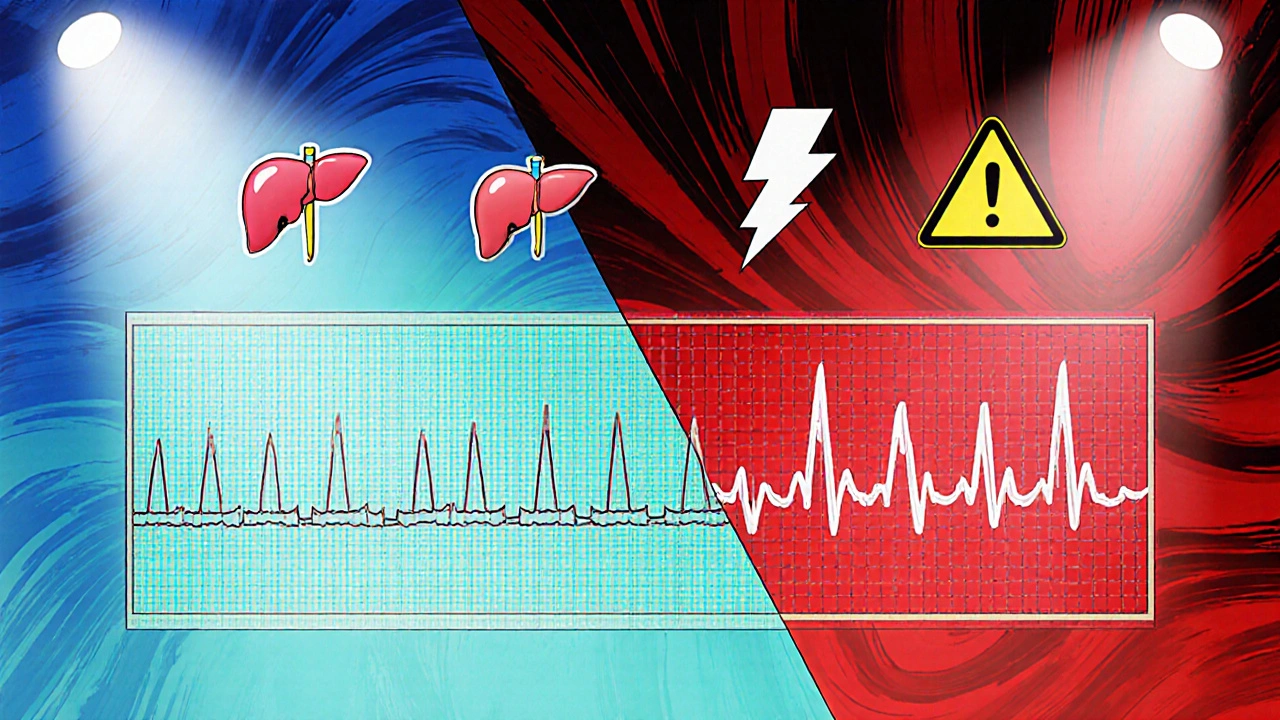Key Takeaways
- Amiodarone can be added to other antiarrhythmics, but only after careful risk‑benefit assessment.
- Class I agents (e.g., Flecainide) and Class III agents (e.g., Sotalol) have the highest pro‑arrhythmic potential when paired with amiodarone.
- Beta‑blockers (e.g., Metoprolol) are the safest adjuncts, providing rate‑control without additive QT prolongation.
- Regular ECG, thyroid, and liver function monitoring cuts the odds of serious adverse events dramatically.
- Know the key CYP450 pathways (CYP3A4) that drive drug‑drug interactions and adjust doses accordingly.
Why Combine Amiodarone with Other Antiarrhythmics?
In complex arrhythmias-especially refractory atrial fibrillation or ventricular tachycardia-single‑drug therapy often falls short. Adding a second agent can help achieve rhythm control, improve hemodynamics, or allow lower doses of each drug, reducing side‑effect burden. However, the combination must be justified: the incremental benefit should outweigh the heightened risk of bradycardia, QT prolongation, or organ toxicity.
Understanding Amiodarone's Pharmacology
Amiodarone is a class III antiarrhythmic that blocks potassium channels, prolongs the action potential, and also exhibits class I, II, and IV properties. Its half‑life can exceed 50 days, and it is metabolized primarily by CYP3A4. Because it accumulates in fat, liver, and lungs, clinicians must monitor thyroid function, liver enzymes, and pulmonary status regularly.
Common Antiarrhythmic Classes Used with Amiodarone
When thinking about combos, classify the partner drug:
- Class I (sodium‑channel blockers) - e.g., Flecainide or propafenone.
- Class II (beta‑blockers) - e.g., Metoprolol, carvedilol.
- Class III (other potassium‑channel blockers) - e.g., Sotalol or dofetilide.
- Class IV (calcium‑channel blockers) - e.g., Diltiazem or verapamil.
- Non‑antiarrhythmic agents with rate‑control benefits - digoxin, anticoagulants.
The safest partners are beta‑blockers and calcium‑channel blockers because they mainly affect heart rate without further lengthening the QT interval. Sodium‑channel blockers and other class III agents raise pro‑arrhythmic risk and demand stricter monitoring.

Safety Profile: Benefits vs. Risks
Below is a quick risk‑benefit snapshot for the most frequent pairings.
| Partner Drug | Primary Benefit | Key Risks | Monitoring Focus |
|---|---|---|---|
| Metoprolol | Rate control, reduced sympathetic tone | Bradycardia, hypotension (additive) | Heart rate, blood pressure, ECG |
| Diltiazem | AV‑node slowing, useful in atrial flutter | QT prolongation (rare), AV block | PR interval, QT interval |
| Flecainide | Enhanced sodium‑channel blockade for refractory SVT | Pro‑arrhythmia, especially in structural heart disease | QRS width, QT interval, cardiac imaging |
| Sotalol | Additional class III effect, beta‑blockade | Severe QT prolongation, torsades de pointes | Serial QTc, electrolytes, renal function |
| Digoxin | Vagal enhancement, useful in heart failure | High‑level bradyarrhythmias, digoxin toxicity | Serum digoxin level, renal function |
Drug‑Drug Interaction Mechanics
Amiodarone is a potent inhibitor of several cytochrome P450 enzymes, especially CYP3A4. This means that co‑administration can raise plasma concentrations of many drugs:
- Warfarin - increased anticoagulant effect; watch INR closely.
- Statins (e.g., simvastatin) - risk of myopathy; consider pravastatin or dose reduction.
- Calcium‑channel blockers - higher levels, leading to hypotension.
Conversely, drugs that induce CYP3A4 (e.g., rifampin, carbamazepine) can lower amiodarone levels, reducing its efficacy.
Practical Dosing Strategies
- Start with a loading phase: 800‑1200 mg daily for 1‑3 weeks, then taper to a maintenance dose (100‑200 mg daily).
- If adding a beta‑blocker, begin at half the usual dose and titrate after two weeks, monitoring heart rate and blood pressure.
- When pairing with a Class I agent, reduce the partner’s dose by 25‑30 % because amiodarone already depresses conduction.
- For a Class III partner like sotalol, keep the amiodarone maintenance dose at the lower end (100 mg) and check QTc after each dose adjustment.
Always adjust for renal or hepatic impairment. For example, in patients with eGFR < 30 mL/min, avoid sotalol altogether and prefer beta‑blockers.

Monitoring Checklist for Clinicians
- Baseline ECG: note QTc, QRS, PR intervals.
- Thyroid panel (TSH, free T4) before starting, then every 6 months.
- Liver enzymes (ALT, AST) at baseline, then quarterly for the first year.
- Chest X‑ray or high‑resolution CT if the patient develops dyspnea (screen for pulmonary toxicity).
- Renal function: serum creatinine, eGFR - especially when using sotalol or digoxin.
- Electrolytes: potassium and magnesium >4 mmol/L and >2 mmol/L respectively to reduce torsades risk.
- Drug‑level checks: warfarin INR, digoxin serum level, statin CK if indicated.
Special Populations
Elderly patients often have reduced hepatic clearance and polypharmacy, making them vulnerable to cumulative toxicity. Start at the low end of the maintenance dose (100 mg) and extend monitoring intervals.
Pregnant women - amiodarone crosses the placenta and may cause fetal thyroid dysfunction. Use only when the benefit clearly outweighs risk, and involve obstetrics early.
Patients with structural heart disease - avoid combining amiodarone with Class I agents like flecainide, as the pro‑arrhythmic risk spikes dramatically.
When to Stop the Combination
Discontinue the adjunct drug if any of the following occurs:
- QTc exceeds 500 ms despite electrolyte correction.
- New‑onset symptomatic bradycardia (<50 bpm) or high‑grade AV block.
- Significant hepatic (ALT >3× ULN) or thyroid dysfunction (TSH >10 µIU/mL).
- Patient reports pulmonary symptoms with infiltrates on imaging.
In most cases, taper the partner drug over 1‑2 weeks while maintaining amiodarone at the lowest effective dose.
Key Takeaways for Practice
- Prefer beta‑blockers or calcium‑channel blockers as add‑on agents.
- Reserve sodium‑channel blockers and other class III drugs for highly selected cases with intensive monitoring.
- Leverage the amiodarone half‑life to achieve steady‑state before adding or withdrawing a partner medication.
- Use the monitoring checklist religiously - early detection of toxicity is the difference between success and serious complications.
- Document the rationale for each combination in the patient’s chart to aid future clinicians.
Can I safely combine amiodarone with flecainide?
Only in very rare, highly controlled situations. Both drugs prolong conduction, so the pair markedly raises the risk of QRS widening and torsades de pointes. If you must, reduce flecainide by at least 30 % and monitor ECG, electrolytes, and renal function daily for the first week.
What is the best beta‑blocker to use with amiodarone?
Metoprolol or carvedilol are typically preferred because they have predictable cardio‑selective effects and limited CYP interactions. Start at half the usual dose and titrate based on heart rate and blood pressure.
How often should I check thyroid function while on amiodarone?
Check TSH and free T4 before starting therapy, then every six months for the first two years. If abnormalities appear, switch to a thyroid‑sparing antiarrhythmic or treat the thyroid disorder while continuing amiodarone at a reduced dose.
Does amiodarone interact with warfarin?
Yes. Amiodarone inhibits warfarin metabolism, often raising INR by 0.5‑1.0 units. After starting amiodarone, check INR within 2‑3 days and adjust the warfarin dose accordingly.
What monitoring is required when adding sotalol to amiodarone?
Because both drugs prolong QT, obtain a baseline ECG, then repeat 24 hours after the first combined dose and after each dose change. Keep potassium >4 mmol/L and magnesium >2 mmol/L, and hold the combination if QTc exceeds 500 ms.

